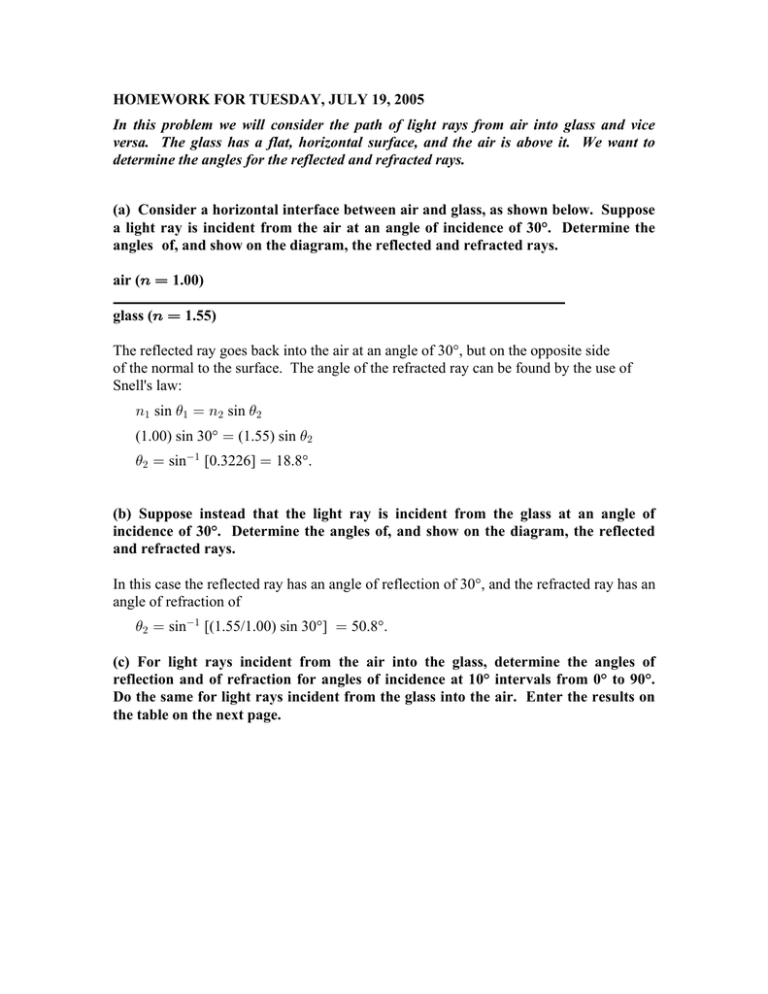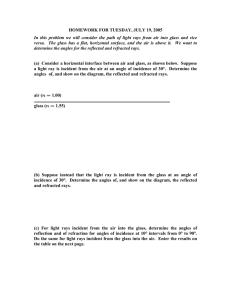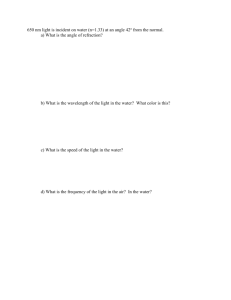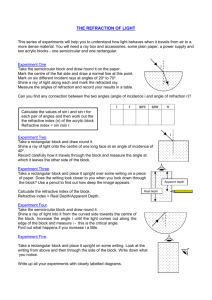HOMEWORK FOR TUESDAY, JULY 19, 2005
advertisement

HOMEWORK FOR TUESDAY, JULY 19, 2005 In this problem we will consider the path of light rays from air into glass and vice versa. The glass has a flat, horizontal surface, and the air is above it. We want to determine the angles for the reflected and refracted rays. (a) Consider a horizontal interface between air and glass, as shown below. Suppose a light ray is incident from the air at an angle of incidence of 30°. Determine the angles of, and show on the diagram, the reflected and refracted rays. air (8 œ 1.00) glass (8 œ 1.55) The reflected ray goes back into the air at an angle of 30°, but on the opposite side of the normal to the surface. The angle of the refracted ray can be found by the use of Snell's law: 8" sin )" œ 8# sin )# (1.00) sin 30° œ (1.55) sin )# )# œ sin" [0.3226] œ 18.8°. (b) Suppose instead that the light ray is incident from the glass at an angle of incidence of 30°. Determine the angles of, and show on the diagram, the reflected and refracted rays. In this case the reflected ray has an angle of reflection of 30°, and the refracted ray has an angle of refraction of )# œ sin" [(1.55/1.00) sin 30°] œ 50.8°. (c) For light rays incident from the air into the glass, determine the angles of reflection and of refraction for angles of incidence at 10° intervals from 0° to 90°. Do the same for light rays incident from the glass into the air. Enter the results on the table on the next page. From air into glass, angles of: incidence reflection refraction From glass into air, angles of: incidence reflection refraction 0° 0° 0° 0° 0° 0° 10° 10° 6.4° 10° 10° 15.6° 20° 20° 12.7° 20° 20° 32.0° 30° 30° 18.8° 30° 30° 50.8° 40° 40° 24.5° 40° 40° 85.1° 50° 50° 29.6° 50° 50° none 60° 60° 34.0° 60° 60° none 70° 70° 37.3° 70° 70° none 80° 80° 39.4° 80° 80° none 90° 90° 40.2° 90° 90° none (d) In part (c) there is a particular angle of incidence from glass into air for which something interesting occurs. Determine what that angle is. Name the phenomenon involved and describe the physical difference between light rays from glass into air that have a smaller angle of incidence than this special angle, and light rays that have a greater angle of incidence. At the angle of incidence for light rays from glass into air for which the angle of refraction is 90°, the angle of incidence must be )" œ sin" [(1.00/1.55) sin 90°] œ sin" (0.645) œ 40.2°. This is the critical angle for total internal reflection. At smaller angles of incidence, the ray from the glass can be refracted out into the air (as well as reflected), but at larger angles it can only be reflected, as there is no solution to Snell's law. (e) Suppose the index of refraction of the glass were greater than 1.55; how would this affect the refraction angles from air into glass and those from glass into air: would they be the same, or larger, or smaller, or what? Would the special angle in (d) be greater or smaller? For a greater value of 8 for the glass, the angles of refraction from air into glass would all be smaller. This can be seen from Snell's law: 8air sin )air œ 8glass sin )glass so )glass œ sin1 cÐ8air Î8glass Ñ sin )air d The angles of refraction from glass into air would all be larger, so the critical angle for total internal reflection would occur at a smaller angle.





